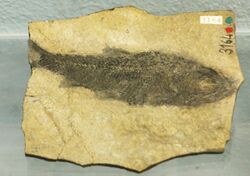Biology:Pholidophoridae
From HandWiki
Short description: Extinct family of ray-finned fishes
| Pholidophoridae | |
|---|---|

| |
| Fossil of Pholidorhynchodon malzanni | |
| Scientific classification | |
| Domain: | Eukaryota |
| Kingdom: | Animalia |
| Phylum: | Chordata |
| Class: | Actinopterygii |
| Order: | †Pholidophoriformes |
| Family: | †Pholidophoridae Woodward, 1890 |
| Genera[3] | |
| |
Pholidophoridae is an extinct family of primitive stem-teleost fish that lived during the Triassic period, from the Anisian age of the Middle Triassic to the Norian age of the Late Triassic. Most of the genera are from Europe, but one (Malingichthys) is known from China.[3] The pholidophorids were historically united with several other stem-teleost lineages into the order Pholidophoriformes, but Pholidophoriformes in its traditional sense is now considered paraphyletic with respect to crown group teleosts.[4]
Phylogeny
Below is a cladogram simplified after Bean (2021):[5]
| Teleosteomorpha |
| ||||||||||||||||||||||||||||||||||||||||||||||||||||||||||||||||||||||||||||||||||||||||||||||||||||||||||||||||||
References
- ↑ Taverne, L. (2018). "The Mesozoic fish genus Pholidophorus (Teleostei, Pholidophoriformes), with an osteological study of the type-species Pholidophorus latiusculus. Comments on some problems concerning the "pholidophoriform" fishes". Geo-Eco-Trop. 42 (1): 89–116. https://geoecotrop.be/uploads/publications/pub_421_07.pdf.
- ↑ Arratia, G.; Schultze, H.-P. (2024). "The oldest teleosts (Teleosteomorpha): their early taxonomic, phenotypic, and ecological diversification during the Triassic". Fossil Record 27 (1): 29–53. doi:10.3897/fr.27.115970.
- ↑ Jump up to: 3.0 3.1 Arratia, G. (2017). "New Triassic teleosts (Actinopterygii, Teleosteomorpha) from northern Italy and their phylogenetic relationships among the most basal teleosts". Journal of Vertebrate Paleontology 37 (2): e1312690. doi:10.1080/02724634.2017.1312690. Bibcode: 2017JVPal..37E2690A. https://www.researchgate.net/publication/317125374.
- ↑ Arratia, G. (2013). "Morphology, taxonomy, and phylogeny of Triassic pholidophorid fishes (Actinopterygii, Teleostei)". Journal of Vertebrate Paleontology 33 (sup1): 1–138. doi:10.1080/02724634.2013.835642. Bibcode: 2013JVPal..33S...1A.
- ↑ Bean, L. B. (2021). "Revision of the Mesozoic freshwater fish clade Archaeomaenidae". Alcheringa: An Australasian Journal of Palaeontology 45 (2): 217–259. doi:10.1080/03115518.2021.1937700. https://www.researchgate.net/publication/353450210.
Wikidata ☰ Q18549934 entry
 |

